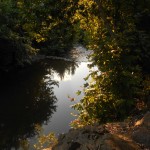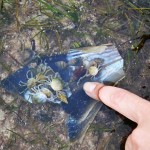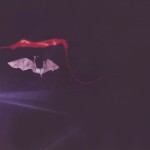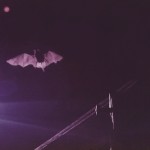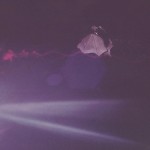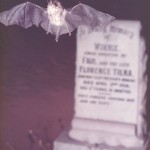In the 2000s, there was a brief craze of unhygienic places having footbaths of water in which you could put your reeking feet in order to have fish nibble at them. This seemed to me like 1. fish abuse, and 2. a good way to catch foot diseases.
When I went to the beautiful Kazdağı National Park in the mountains above the Aegean coast of Turkey, I found that the fish were willing to do this pedicure treatment in the wild. Normally, fish scatter and disappear when you swim in their river. However, just dipping your feet in the river in the picture above would bring a swarm of tiny fish to you. They would chew on your feet if they could get to them. They would also nibble at any part that you put in. A bit off-putting at first, but they never seemed to get hurt by limbs flailing about when I was swimming. Eventually, I just got used to being surrounded by a cloud of orally familiar fish.
There is a place near Sivas in Turkey that claims to use temperature-resistant fish for treating psoriasis. Go for it.
Now, the crabs. The east coast of Yorke Peninsula in South Australia has crystal waters and a high tidal range. If you go for a walk on Sultana Point near Edithburgh at low tide, there is a fascinating array of marine life to see. My 2-year-old daughter and I were eating razorfish (Pinna bicolor). This necessitated cracking open sharp shells and doing a lot of cleaning of stuff inside. After a bit of work, we would get an edible morsel that she would eagerly chew before demanding more. The detritus would attract all sorts of animals, including some small mud crabs.
When the supply of razorfish guts ran out, the crabs would nibble our feet. They were quite insistent with some bits of loose skin but never went as far as causing pain. I don’t know whether the concept of crab pedicures would take off like the fish ones did. There’s a business idea for you.
I suppose these foot-loving creatures would correctly be called pedophiles. Not paedophiles.

Posted February 3, 2014 Posted by Adam in Uncategorized
In the 2000s, there was a brief craze of unhygienic places having footbaths of water in which you could put your reeking feet in order to have fish nibble at them. This seemed to me like 1, fish abuse and 2. a good way to catch foot diseases.
When I went to the beautiful Kazdağı National Park in the mountains above the Aegean coast of Turkey, I found that the fish were willing to do this pedicure treatment in the wild. Normally, fish scatter and disappear when you swim in their river. However, just dipping your feet in the river in the picture above would bring a swarm of tiny fish to you. They would chew on your feet if they could get to them. They would also nibble at any part that you put in. A bit off-putting at first, but they never seemed to get hurt by limbs flailing about when I was swimming. Eventually, I just got used to being surrounded by a cloud of orally familiar fish.
There is a place near Sivas in Turkey that claims to use temperature-resistant fish for treating psoriasis. Go for it.
Now, the crabs. The east coast of Yorke Peninsula in South Australia has crystal waters and a high tidal range. If you go for a walk on Sultana Point near Edithburgh at low tide, there is a fascinating array of marine life to see. My 2-year-old daughter and I were eating razorfish (Pinna bicolor). This necessitated cracking open sharp shells and doing a lot of cleaning of stuff inside. After a bit of work, we would get an edible morsel that she would eagerly chew before demanding more. The detritus would attract all sorts of animals, including some small mud crabs.
When the supply of razorfish guts ran out, the crabs would nibble our feet. They were quite insistent with some bits of loose skin but never went as far as causing pain. I don’t know whether the concept of crab pedicures would take off like the fish ones did. There’s a business idea for you.
I suppose these foot-loving creatures would correctly be called pedophiles. Not paedophiles.
Posted January 31, 2014 Posted by Adam in Uncategorized
Not a car for Batman but a mobile made from bats.
The school at which I worked in outback South Australia had the only swimming pool for hundreds of kilometres. The local bats would skim over it at night and drink. Occasionally, some of them would misjudge their trajectory and I would find them floating when I got to school in the morning. Some of them were alive and my treatment of quiet darkness followed by mincemeat in raw egg would allow them to recover.
When I first found a dead bat, I thought it would be a waste not to use it. My embryonic taxidermic skills were not equal to the task of stuffing something that small. I arranged the bat in a vaguely lifelike posture and injected its body cavities with a formaldehyde (methanal) solution. After several courses of injection, I had a fairly permanent specimen. The best way to display it was by attaching a single thread so it could hang from the ceiling and give the impression of being in flight.
After I had a few of these, I had the idea of displaying them as a mobile, similar to those made by Alexander Calder. I made a nicely balanced one with four or five bats. I don’t have a picture of it but I did once take one of the single hanging bats (A Lesser Long-eared Bat, Nyctophilus geoffroyi) into a country graveyard to take some pictures.
I made quite a lot of taxidermic specimens while I was at that school. On one occasion, I was preparing a Hoary-headed Grebe (Poliocephalus poliocephalus, one of the least pleasant scientific names I have read) with the formaldehyde injection method when the needle came off the syringe. I got an eyeful of formaldehyde, one of the most painful things that has ever happened to me. I thought it would permanently affect my vision but after an hour of lying down under a running water tap, I seemed to be OK.
I left that school with a ceiling full of stuffed flying things, including a really ugly Pied Cormorant (Phalocrocorax varius) that hung directly over where the teacher normally stood in the science laboratory. I imagine that the first thing that was done when I left that school was a cleanout of all my horrible specimens.
Click on the thumbnails for bigger pictures.

Posted January 31, 2014 Posted by Adam in Uncategorized
This sounds like more fun than it was. I used to work in a girls’ school in England. There were a lot of charitable activities. In one of these, someone had the wonderful idea of bringing in someone to wax some of the teachers for charity. I think I volunteered to get my legs waxed but the comically hairy nature of my back was revealed by some of my ‘friends’ with whom I went swimming. Hence, one lunch time, there I was on the stage in the main hall, lying on what looked like a surgical bench, with an efficient woman tearing clumps of hair from my back. Not such a bad idea, I thought.
At this stage, a colleague thought we might be able to make a bit more money if students paid a pound for the privilege of tearing one of the strips off. Then followed an unending stream of girls queuing for the unique sensation of ripping hair off a male teacher and seeing him in pain. Things became worse when we ran out of back hair and shifted to the chest. I could probably have called a halt at this stage but the general air of excitement and continued calls of ‘We’re making so much money’ meant that the uproar would have been considerable.
The chest waxing really hurt. Each waxing strip looked like a dead squirrel when it came off and left a field of pinpricks on my chest. There was quite a bit of blood. The girls were fascinated. The look of schadenfreude when some of them ripped another patch of skin off me was frightening. The whole horrible thing was only halted by the bell at the end of lunch time. The waxing woman decided to end with a flourish and wax all of my chest except for a little hairy heart right in the centre. My wife did not find this in any way funny or stylish or romantic.
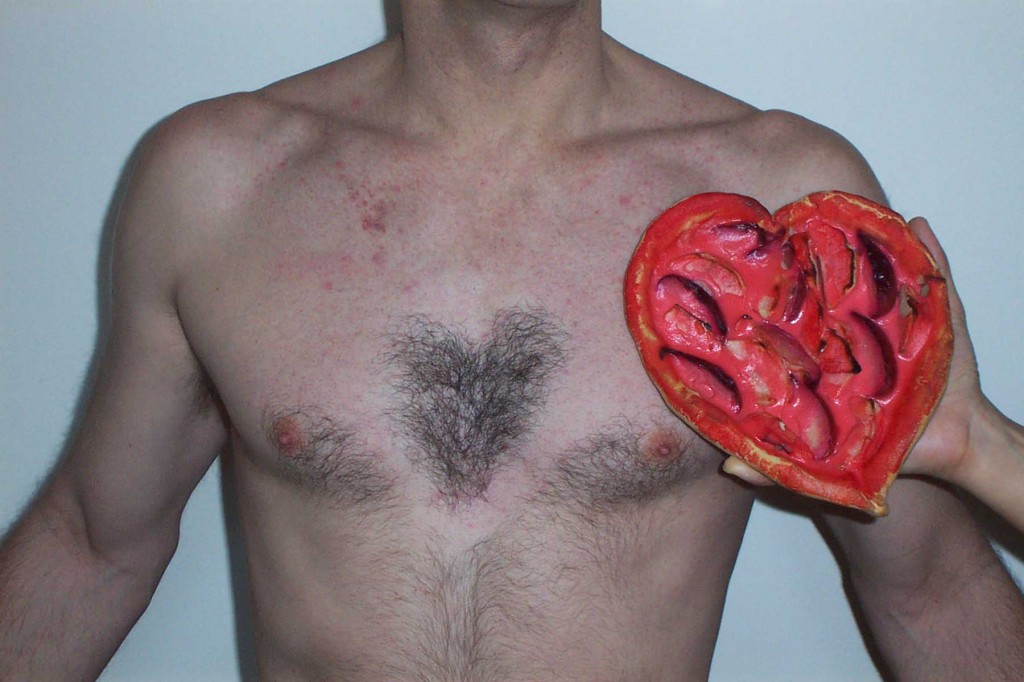
The Heart of Hair, complemented by a similarly Valentinic pastry

Posted November 11, 2013 Posted by Adam in Uncategorized
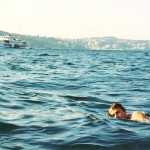 This picture is from an earlier swim across the Bosphorus.
This picture is from an earlier swim across the Bosphorus.
“Do you want to swim the Çanakkale Boğazı?” Mehmet asked me. Mehmet had already swum the Dardanelles a few times and had got me involved in a race across the Bosphorus the previous year in which I had placed close to last in a large field.
But did I want to swim the Dardanelles? I thought of Hero and Leander, Xerxes and the Persian army, Lord Byron, World War I. Of course I did. Or rather, I wanted to have done it. I wasn’t sure about the actual swimming. I remembered Çanakkale Boğazı as significantly wider than its İstanbul counterpart.
“Yes?” He knew I would. “The race is on Saturday August 30th. You have to register in Çanakkale before 5 p.m. on the Friday before.” OK, so now I was going to do it.
. . . . .
My bedraggled-looking 1982 Ford Escort sat there and glared at me. I couldn’t see any loose connections in the electrical system. But when I turned the ignition key, there was no starter motor sound. It had done this three months ago but not since then. I knew if I waited an hour, it would go back to normal and start without any problems. But I didn’t have an hour. I was near Tekirdağ and in a hurry to get to Çanakkale before five.
The Oto Elektrikçi made an eloquent face as I realised how the Escort’s filthy engine compartment must look to a professional. He started it with a screwdriver and some bits of wire, then said it was a dynamo problem and he could fix it in an hour. I didn’t think it was the dynamo, was fairly sure that one hour would stretch to three and I didn’t have an hour to spare anyway. I paid him and continued.
A road map supplied by a major daily newspaper showed a main road along the Marmara coast from Kumbağ to Şarköy. Great, a short-cut. Unfortunately after Kumbağ, the road degenerated into a pitted track covered in grass. Rocks stuck up 30cm from the surface in an engine-threatening manner. Occasional showers of stones bounced across the road from the high cliffs on the right. The recent rains had raised the water table and fresh water bubbled up in the middle of the road. Rockfalls on the right coincided with washaways on the left.
The car hated it. The temperature gauge shot up to maximum and I smelled steam. I didn’t dare stop. I had only seen one vehicle since Kumbağ – some brave soul on a motorcycle. The track followed the terrain and the gradients were frighteningly steep. The car swore at me and growled on.
But the views were magnificent. Wild mountains plunged down to the serene Marmara. Secluded beaches nestled in green coves. Cultivated patches were visible on tiny squares of flat land.
I came to a beautiful cliff-hugging village inevitably called Yeniköy and drove past donkeys, goats and curious men outside the coffee-house. The road got worse. Sometimes it seemed to disappear altogether but when I steered through the least rocky areas, there it was again. I was treated to the sight of waterfalls plunging to the road and carving bits of it out.
Then came heaven in the shape of Uçmakdere, a tobacco-growing village with a track leading to a beach. Some lucky Türks had heard about the place and were having their holiday there. One day, I will too.
The road got better after Uçmakdere and the little Escort sped through Şarköy, Gelibolu and into Eceabat to join the queue for the Çanakkale ferry. It was 3:55. I had to catch the 4 p.m. ferry or I wouldn’t be able to register and the trip would have been in vain. I tried to restart the car. Nothing. Same problem.
I would have to leave the car here. But not in the ferry queue. I spotted an empty parking space 100 metres away and started pushing. A friendly simitçi saw my efforts and leaped to help me. Made it. I grabbed my bag, locked the car and ran.
I bought my jeton from a man who looked and moved like a Galapagos tortoise and sprinted through the gate with the simitçi cheering me on. The ferry was moving. I hurled my bag over the raised vehicle ramp, leapt for the railing at the side, clung on and hauled myself on board. I wondered if any other swimmers were training for the race like this.
It seemed a long ferry crossing. I looked around at the coastlines and tried to figure out the race route. They’ll choose the easiest way, I thought. Maybe from that point on the Asian side to that big castle at Kilitbahir, directly opposite Çanakkale. I began to feel quite good about it. The current would carry me most of the way if I got lazy.
I tried not to look down where there was a plague of those enormous purple-tentacled jellyfish which get swept down from the Black Sea. I wondered what it was like to swim through them.
In Çanakkale, I found an office marked “Information” so I went in and asked where I should enter for the swimming marathon. A helpful girl pointed at the road to İzmir on a map. What? I repeated my request. This time, she pointed out some nice swimming bays near Çanakkale. No, no, no. “Yüzme maratonu. Yarın. Çanakkale Boğazı Geçme Yarışması.” “No,” she said with finality.
Someone was listening though, and after a few phone calls, he had found out where I should register. I jumped into a taxi, got to the 18 Mart Stadium and found the right building. A man was waiting for me and helped me fill in my form. Done it. It was 4:57. I congratulated myself on my careful planning and impeccable timing.
I found a pansiyon, then headed back on the ferry to see about my car. The crossing seemed longer than ever and the jellyfish were increasing. Good thing we won’t be swimming this way.
. . . . .
My tyre’s flat. But every car here has a flat tyre. I’ve parked in the place reserved for dolmuş drivers. I guess they didn’t like that. Oh well, better than a wheel clamp and a fine. I change the tyre. The car starts first time and sits there giggling at me.
I drive to the Oto Sanayı, pump up my tyre and put it back on. The Oto Elektrikçi looks at my car. “There is no problem.” I explain that the problem only happens if I have driven fast for a few hundred kilometres. “Bring it back when you’ve driven fast for a few hundred kilometres,” he retorts, and goes away. Meanwhile, a small boy has washed the battery with gallons of water which have seeped through the air vents and made a small lake inside the car. I tip him for this and slosh back to the ferry terminal.
Next day, I find the place where the Çanakkale Rotary Club has set up race headquarters. I meet Peter and Susan, a distinguished-looking American couple. They know the headmaster who hired me at an American school in İstanbul and Susan has just written a book about Troy. We have our blood pressures taken. There is concern when Peter’s is reported as 28 but two leaps of understanding later, it turns out to be 120 over 80. He’s all right.
There’s mass movement afoot so I follow the crowd to two boats and sit on the roof of one with a bunch of alarmingly fit-looking young men who are discussing race tactics. Last on board is Mehmet with his all-swimming family. He says, “We managed to register you by fax. You didn’t need to come yesterday but we couldn’t contact you.”
The boat starts off. We’re heading towards Eceabat. I wasn’t expecting that. I ask where we start from. “The ferry dock at Eceabat.” It turns out that we’re swimming further than the ferry goes. I start to worry. More than five kilometres? Oh, dear.
Knowing my interest in biology, Mehmet begins to tell me about the sharks that a relative of his saw whilst diving at World War I shipwrecks just beneath us. Some helpful points about how to tell if a shark is about to attack improve my confidence.
The frighteningly healthy youths strip down to purposeful-looking racing trunks and cover themselves in pink grease. They do professional stretching exercises. They agree on the ideal strategy for the race. They will head directly for the very tall radio mast on the European shore. This ensures that they will not be carried too far downstream by the current. Then they will head in a graded curve along the bay and be swept with precision between the buoys which mark the finish. An excellent plan, I think. If only I could have done it.
We reach the ferry dock. Race marshals make sure of numbers and issue bathing caps. I stretch the yellow rubber over my head and presume that now I am safe from any hazards.
Without apparent warning, people start jumping into the sea. I push through a crowd of men with stopwatches and jump into a space between crowds of small boats. The start is a mass of kicking legs as we sort ourselves out into positions in which we can actually start to swim.
I find the radio mast on the opposite shore and commence the enormous task of heading towards it. The Asian shore may as well be the Australian coast for all the hope I have of reaching it. I look back at the ferry dock. To my surprise, it’s already a long way behind. It doesn’t make the far shore look any closer but it’s encouraging.
I put my head down and try to get some distance covered. I look up. Where’s the tower? Turn 30 degrees. Swim again. Eventually, I resign myself to alternating my faster crawl (freestyle) with a breaststroke which gives me a bit of a breather and lets me correct my course.
I bump into a group of swimmers. We recognise each other from the boat, have a short conversation and get back to business. The atmosphere is great. It’s the swimming that’s the problem.
There are dozens of boats around. Knowledgeable-looking men occasionally drive up to me and give me instructions along with a face full of exhaust gases. I look around. Most swimmers seem to be ahead of me and upstream. No matter. I keep swimming towards the radio tower.
The castle at Kilitbahir is now in sight. I’ve swum far enough to see some progress. Head down again. Looking underwater is like swimming in a 60’s Lava Lamp. Out-of-focus blobs of jellyfish everywhere. They’re not too bad so far. None of those Black Sea monsters.
I remember Xerxes and his bridge of boats. How many hundreds of boats did he use? Maybe I could build a bridge of jellyfish. A man on a boat tells me to be careful of the current. I look up. The tower has slipped off to the left a bit.
Leander swam there and back every night? He must really have loved that girl. How did he have any energy left when he got there? Was there any point in making the swim? He must have had muscles like cannonballs.
The jellyfish have disappeared for a while but have been replaced by mats of grass or seaweed which get caught on my hands. I look to the right again. I can see open water to the south-west between the Asian and European shores. I guess that’s why the current is getting stronger. Back to work.
A bit more hard swimming. I can see the buildings of Çanakkale clearly now. A couple of patrol boats up ahead. I see the model of the Nusret, the heroic minelayer from World War I. Just to the left of it is a patch of trees which marks the finish. It doesn’t look too far now.
I remember someone telling me about a negative current if I get too close to the shore. So I don’t. I start swimming straight to the target. There are two or three swimmers near me doing the same thing. Nearly there. One last effort.
I hear yelling. I look up. There is a boat either side of me. People are shouting at me to swim upstream. I look to the shore. I’m level with the Nusret. People standing near it are gesturing urgently towards the left.
And I’ve lost sight of the finish line. I’ve been swept around a point. No negative current here – the entire force of water from the Sea of Marmara is shoving me towards the Aegean. I swim as fast as I can but make no headway. Damn the Dardanelles! The only thing I can do is swim towards the shore.
In the shelter of the land, I can make some progress. But when I get to the little headland, the current hits me again. There’s a boat moored to a jetty there. This is the hardest part. I swim as hard as I can for what seems like ages. I look up. I have moved no distance at all. This is horrible. This is the last time I try to emulate Lord Byron.
I let myself drop back, then swim between the boat and the jetty. That’s easier. I wave at the people peering down through the narrow gap. They give me a bit of a cheer.
I’m through. I swim in calm water to the beach. Mehmet and another swimmer are just taking in the buoys which mark the finish line. That makes me the last official finisher. I stagger onto the shore. I don’t feel really tired, just as if I’ve been on a boat for a week and can’t remember how to walk on land.
“Hello.” Mehmet is unruffled, as always. “I guess you went a bit far with the current.” I watch another couple of swimmers lurch out of the water. I know how they feel.
I meet Peter and Susan. Susan made it despite some early cramps. She’s talking about a swim from Abydos to Sestos, Leander’s actual route in the legend. Peter is looking superior. He got on a boat half way through and doesn’t look dead, like we do.
We watch the awards ceremony. Mehmet, his mother and his younger brother appear an inordinate amount of times to collect prizes. I get my participation certificate, made out in a name that almost, but not entirely, unrecognisable as mine.
Mehmet’s final words are, “It will be much easier next year. You know where you went wrong.”


